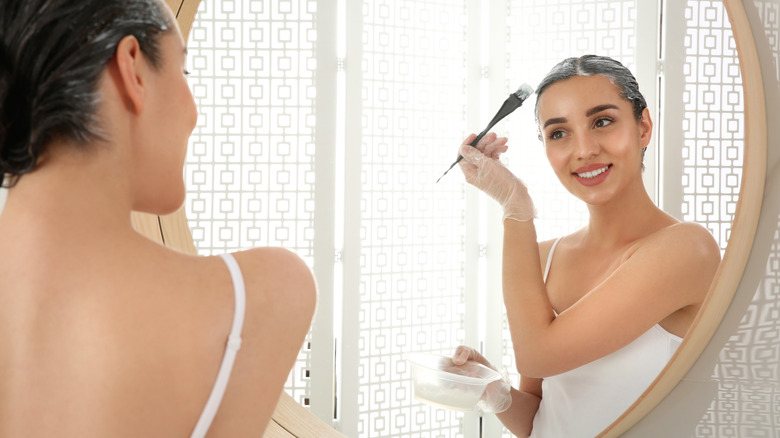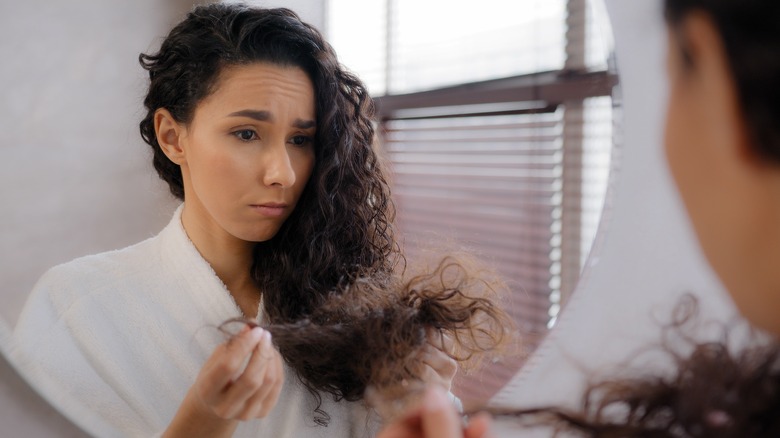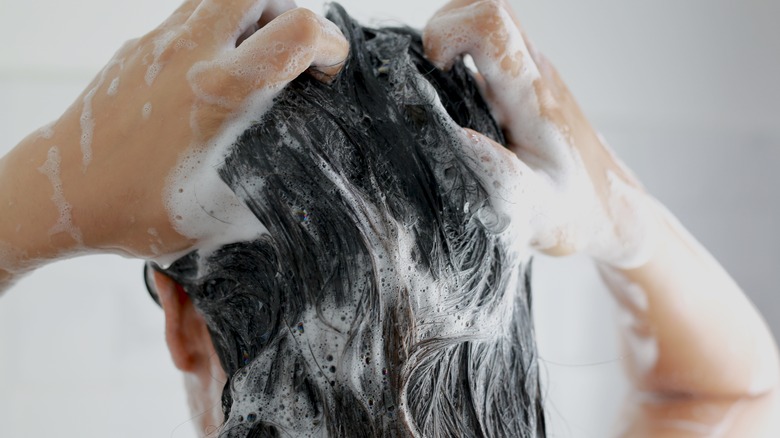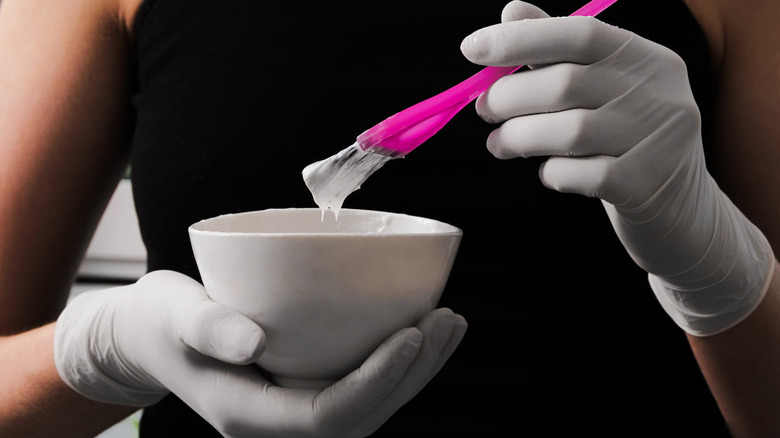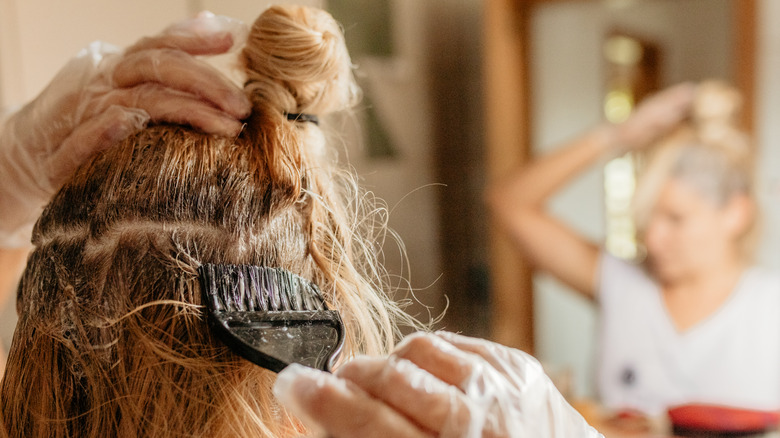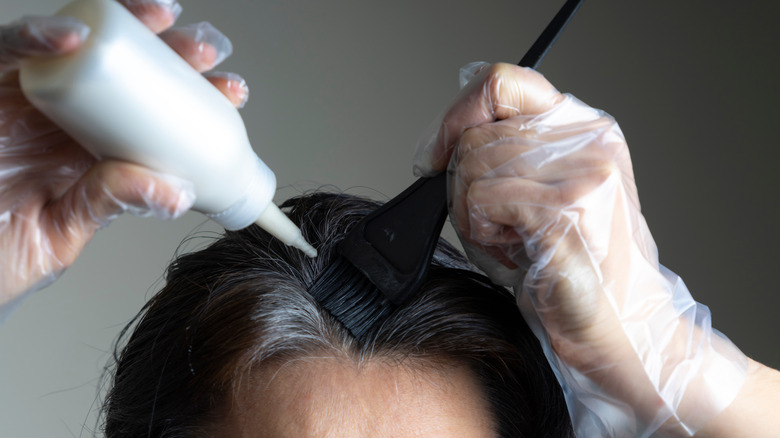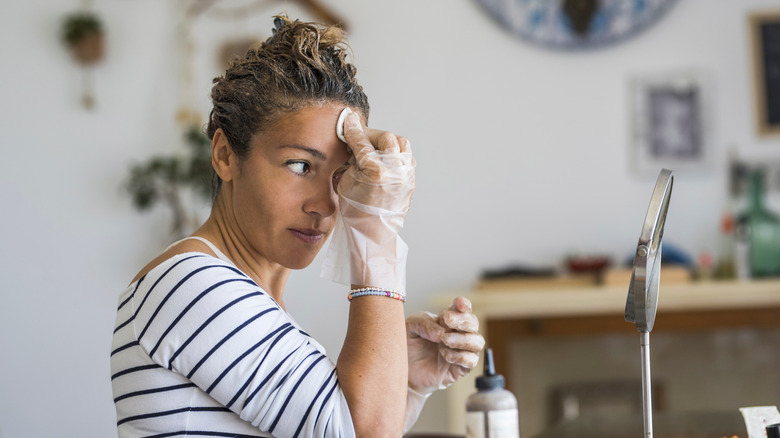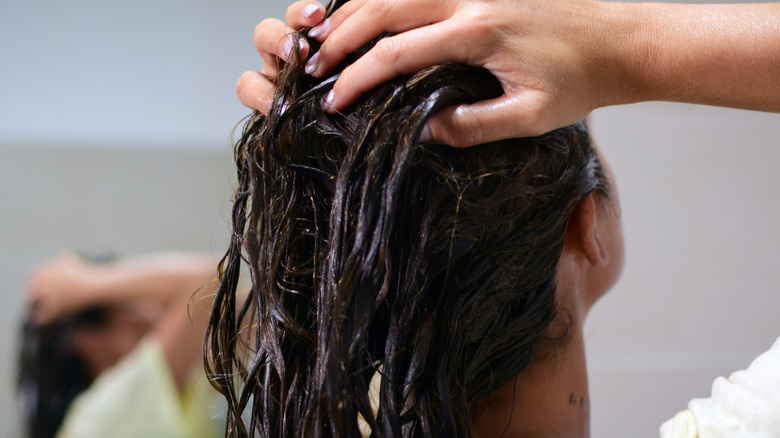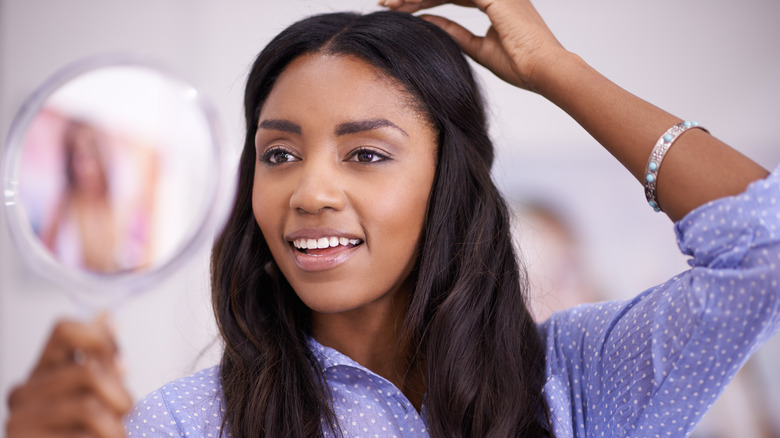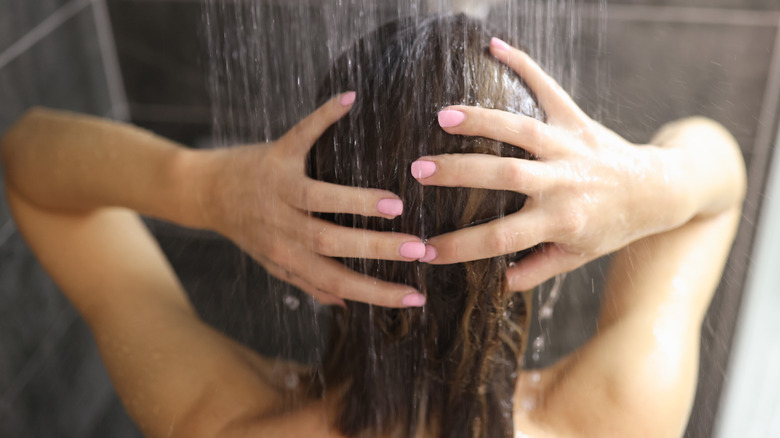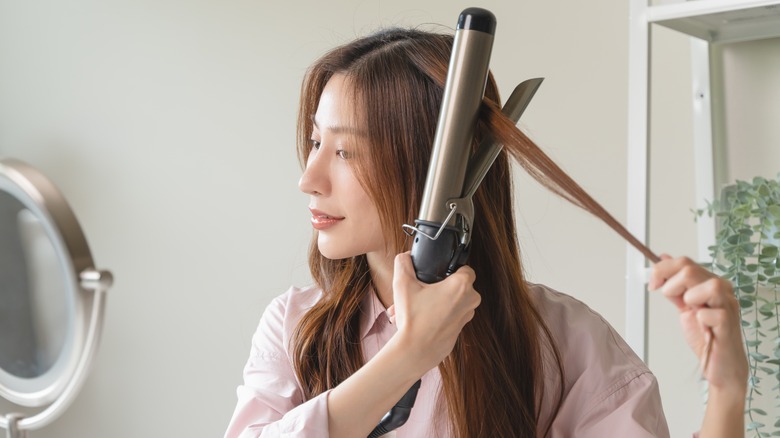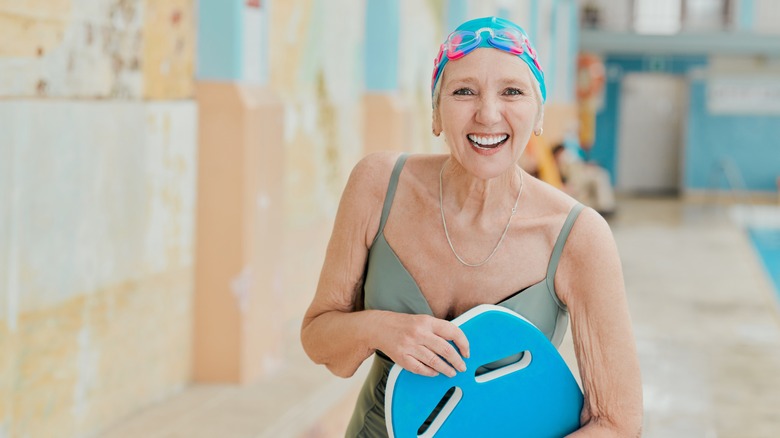11 Mistakes To Avoid When Dyeing Your Hair At Home
Are you thinking about dyeing your hair at home? Not everyone has enough time or money to visit the salon to get their hair professionally dyed. Dyeing your hair at home might occasionally be the only option, as it was during the height of the COVID-19 pandemic. That being said, some people make mistakes when they are dyeing their own hair.
Selecting the right color to dye your hair is important, and the types of hair dye play a part as well. Semi-permanent hair dye is excellent for a low-commitment look, while permanent hair dye is the perfect option if you want a long-term hair color change. Semi-permanent hair dye tends to rinse out of your hair within four to 20 shampoos, and permanent hair dye lasts much longer.
Additionally, you want to make sure you purchase enough boxes or kits of hair dye (depending on the brand and type). For example, one box might be enough dye for short or thin hair, but if your hair is at least shoulder length and on the thicker side, then you probably need at least two boxes of hair dye. Whether you're dyeing your hair for the first time or you're a hair-dyeing veteran, there's always more to learn. Here are some of the top mistakes to avoid when dyeing your hair at home.
Don't dye damaged hair
One of the biggest hair dye mistakes you can make is dyeing your hair when it is already damaged. Dyeing your damaged, dry, split end-riddled hair with chemicals will only damage your hair further. Keep in mind that using hair dye from a box is less expensive than dyeing your hair at a salon because boxed hair dye is formulated stronger than the kind you would find at a salon.
"Box dye is usually a more concentrated formula because it has to work on everyone's hair," hairstylist and salon owner Sabit Hantal tells Sunday Edit. "Because it is formulated so strongly, that's where the risks are." Considering box hair dye on its own isn't the healthiest idea, if you want your hair to be happy and healthy, using intense chemicals on your already-damaged hair is not recommended.
Another massive downside of dyeing your treated or damaged hair is that your hair will end up being much darker than you desire, especially at the ends, where there is more breakage. Damaged hair is highly porous, meaning it will soak up all that dye. You probably don't want lighter hair color around your crown and roots and darker hair at the ends. If you already have damaged hair, your best course of action would be to get your hair dyed at a professional hair salon.
Don't wash your hair right before dyeing it
Avoid washing your hair less than 24 hours before you dye it. The natural oils on your scalp are there for a reason — to protect the scalp. These oils come in handy when you go to apply chemicals to your hair, as the oils can create a protective layer of sorts. When you wash your hair within 24 hours of applying the hair color, the hair dye will cause your clean scalp to experience pain and irritation. On the flip side, applying hair dye to unwashed hair protects both your hair and scalp from the dye and any ensuing irritation.
"The grease serves as an extra coating so that when we go to break down the cuticle, there's less damage and breakage to the hair and irritation to your scalp," hairstylist Terri Fe' tells Makeup.com. If you do choose to dye your hair right after washing it, keep in mind that your scalp will have much less of a protective barrier. In this case, you should use a hair dye that is free of ammonia for less chance of pain and irritation.
Don't use the wrong developer
Another big mistake you can make when dyeing your hair at home is using the wrong developer. A hair developer is an oxidant cream that expands the cuticles and enables the dye to settle into your hair down to the roots. The developer helps penetrate the dye into the hair shaft and assists it in becoming permanent color.
Typically, the correct developer comes in the package with the boxed hair dye or kit. However, some hair dyes are sold individually, requiring you to purchase the developer separately. In this case, only use a developer that is recommended for the hair color you're using. This will typically be a developer from the same brand and series as the hair dye. If you do use the wrong developer, your hair color can end up being the wrong shade, spotty, or uneven.
The hair developer you choose will depend on your hair type, hair quality, and the degree of lightning. Most beauty supply stores sell developers beginning at 10 volume, which is typically suitable for depositing hair color that is a similar shade (or a bit darker) than your current hair color. If you are looking to lift your hair a few levels or need to cover gray hairs, go with 20 volume. For a stronger lift, a 30 or 40-volume developer works best.
Don't color your hair unevenly
Another huge hair dyeing mistake is coloring your hair strands unevenly. It helps to section your hair into smaller pieces and dye your strands in a particular order. That being said, unless you have very short hair, it may be difficult to dye your strands evenly at home.
It helps to ask someone else for help with dyeing your hair, particularly if you have fairly long hair, since you don't want your DIY hair-dye journey to end with ends or roots that are too dark or splotchy. It also helps to dye your strands beginning at the back of your head, moving onto the hair strands at your temples, and ending with the hair strands at your crown.
You should first apply the hair dye to your roots, then spread the dye along the whole length of your hair. This is because the root area is where hair regrowth begins, and it tends to be the least damaged, so it needs the longest processing time and the most hair color. If you don't have anybody nearby to assist with the back of your head, don't panic — it's possible to get great results when dyeing your hair on your own. Just utilize as many mirrors as you can, and take your time!
Don't forget to follow the hair dye instructions carefully
It's essential to follow the hair dye manufacturer's instructions to properly dye your hair. You might skip out on reading all of the directions when it comes to common household appliances like microwaves or toasters, but it is crucial that you not skip this step when it comes to dyeing your hair at home. It's important to know how to properly mix the hair dye and how long to leave the dye on. If you don't carefully follow all of the hair dye instructions, you will probably end up with hair dye results that are less than ideal, whether that means uneven hair color or worse — damaged hair.
Even if you have dyed your hair multiple times before, giving the directions a thorough pass before the application is a good idea. However, it is particularly important to follow the directions if this is your very first time coloring your hair (even if you are only dying your roots), as well as if you are using a different brand of hair dye than usual. Even if you have already used this brand before, you should still read through the directions to ensure you don't forget anything.
Don't stain your skin or clothing
Another big mistake that people make when coloring their hair at home for the first (or millionth) time is staining their clothing or skin with the hair dye. That's why it's a good idea to wrap a towel around your neck to avoid staining your skin or clothes. Most hair dye kits come with gloves included, so make sure that you use those gloves to protect and take care of your hands.
It also helps to apply cream or petroleum jelly to your neck and around your ears to keep the dye from staining the skin in those areas. You can wipe the cream or petroleum jelly off your skin after shampooing your hair following the hair dye process. However, don't worry if you do end up staining your skin during the hair dye process. You can use any type of oil to clean the hair dye stains from your skin.
In addition to wearing protective gloves, you can also wear a cape while dyeing your hair to protect both your clothing and skin. If you don't have a cape on hand, an old long-sleeved shirt and long pants will do the trick.
Don't leave the hair dye on for too long (or not long enough)
Make sure to always set a timer when you're dyeing your hair at home so you leave the hair dye on for the appropriate amount of time. Leaving the dye on your hair for too much or too little time can have a negative impact on your overall hair health and color.
If you are coloring your hair a darker shake, like dark brown, leaving the color on your hair for too long can make your strands darker than you want — nearly black. On the flip side, if you are dyeing your locks a lighter color, like platinum blond, and you leave the lightning product longer than the instructions recommend, you can end up severely damaging your hair. This significant hair damage often looks like hair breakage or dry, brittle, and weak hair. In severe cases, leaving certain chemicals (like bleach) on for too long can lead to hair loss.
That's why it's crucial to set a timer when you put the product in your strands to ensure that you leave the color on your locks for just the right amount of time, as outlined in the product manufacturer's instructions. It also helps to use a high-quality conditioner and shampoo the next time you wash your hair after coloring to help the new color stay vibrant, last longer, and look and feel salon quality.
Don't forget to style your hair at the end
Another hair dyeing mistake that many people make when coloring their hair at home is not taking the time to properly style their hair afterward. Giving yourself a blowout will allow you to see how your newly-colored hair looks when it's styled and how even the hair color seems (and maybe see areas of improvement if a second dye job is needed). Styling your hair also allows you to fully appreciate your DIY hair-dye job.
To blow dry your hair to perfection without all the damage, make sure you are using the coolest setting on your blow dryer so the strands aren't undergoing any more stress from the heat. Don't forget to give your strands a boost of shine with some hair oil. Another huge benefit of blow drying and styling your hair is that an excellent blowout with just the right tools and products can last for multiple days.
Don't look at this process as a chore. Look at the entire hair dyeing, blow drying, and styling process as an opportunity to truly pamper yourself. If you have some extra time on your hands, consider following up the blowout with a fresh DIY mani and pedi.
Don't shampoo your hair the next day
Another big mistake that many people make when coloring their hair, whether it's a DIY dye job at home or a professional color at the salon, is washing their hair within a couple of days after getting it dyed. If you're typically a daily hair washer, this tip might be difficult, but it's crucial to avoid washing your hair for at least a day or two after dyeing it at home.
It's best to wait for at least 48 to 72 hours after coloring your locks to wash your hair to give your hair cuticles the proper amount of time to close and for the dye to settle into your strands. If you gave yourself a fresh and gorgeous blowout the day you dyed your hair, you wouldn't need to wash it for at least a few days anyway!
When you do finally shampoo and condition your hair, make sure to use shampoo and conditioner that is meant for color-treated hair. Unfortunately, some shampoo and conditioner formulas will strip the dye from your hair too fast, resulting in dull-looking locks. Hot water can also strip the color from your hair, so make sure that the water is not too hot when you do finally give your hair a wash.
Don't use hot tools after dyeing your hair
After getting a professional dye job at the salon, you may walk out with glamorous curls or sleek-straight flat-ironed hair. However, a good rule of thumb is to wait a few days after dyeing your hair at home before going in with any hot tools. The extra heat from these hot tools can lead to faded hair color or dry and damaged strands, particularly after your hair has been chemically treated with dye.
"I see so many people blow-dry their hair and then hit it with a flat or curling iron, and you can actually see where the color has lifted ..." New York City-based colorist Jackie Seabrooke tells NewBeauty. However, If you really want to style your hair with hot tools like curling irons or flat irons that touch your hair with heat, it's best to use a heat-protectant spray to prevent damage. "A heat protectant will reduce moisture loss from inside the hair and smooth the outside, protecting it from humidity, which will also help maintain your color," Seabrooke adds.
But, if you can manage it, it's best to wait at least a few days to use these tools to protect your newly-colored tresses from any unnecessary heat. And while it's crucial not to use these hot tools right after dyeing your hair, you should always avoid overusing curling irons or flat irons to protect your locks — regardless if your hair was recently dyed or not.
Don't forget to protect your hair during the summer
Another big hair-dyeing mistake many people make — that they may not even realize they are doing — is failing to protect their hair throughout the summer. Just like you need to protect your skin from the sun in the summer, the same is true for your hair. You come into contact with many hair-damaging stressors during the summertime, from chlorine to UV rays.
This is doubly true if you tend to spend long hours outside in the sun during the summer or take part in a lot of water sports. When you guard your hair against these external factors, you ensure that your hair won't get too dry and your new hair color won't fade too quickly. If you are planning to go swimming or go in the water at all, make sure to prep your color-treated strands before you swim and take care of your locks after.
"If you are exposed to chlorine or mineral springs, wet your hair before you go in the water, apply conditioner, and consider a swim cap," celebrity hairstylist Christine Thompson recommends to Reader's Digest. And if you sport a head of blond tresses, you'll definitely want to avoid swimming in pools, as the copper in the water mixed with the chlorine can turn your hair green (but don't worry, we have tips on fixing blond hair that's turned green, too, if you just couldn't help it).
